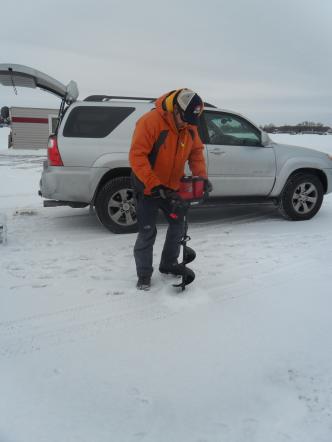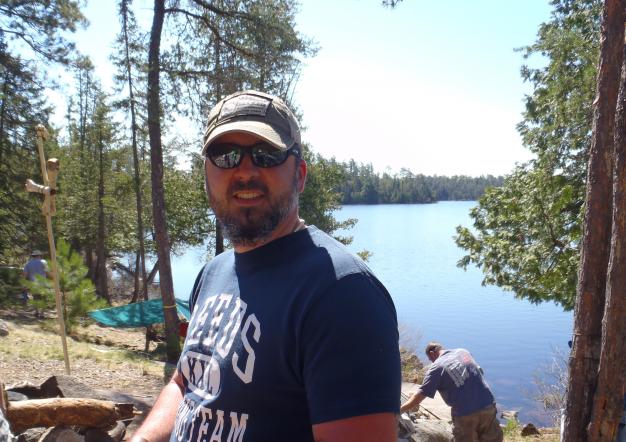This is the fifth post in a series about hunting for food -- truly meeting your meat. Also check out the earlier posts from the series: Squirrel Hunting with Mom, Duck Hunting, An Unsuccessful Pheasant Hunt, and Mom Bags Her First Deer.
There is an old saying that goes, “If you give a man a fish he will eat for the night; if you teach a man to fish he will eat for the rest of his life.” What most people don't know is that here in Minnesota and other parts of the north there is a third part to that saying: If you teach a man to ice fish, he will build elaborate houses on the ice to drink beer in.
 Drilling a hole in the iceI have been ice fishing for most of my life;
over that lifetime ice fishing has changed, a lot. Ice fishing houses used to
be plywood shacks with wood burning stoves that were dragged out onto the ice
and left in one spot until they had to be removed from the ice. Today’s ice
houses are more like small campers that raise and lower on and off the ice with
bunk beds, propane heaters, and generators. The days of stick poles and five
gallon buckets are gone and have been replaced by pop up ice houses, electric
ice augers, and vexlar fish finders. The one thing that hasn't changed is our
fascination with ice fishing. What is it that drives us out onto the ice to try
to catch fish?
Drilling a hole in the iceI have been ice fishing for most of my life;
over that lifetime ice fishing has changed, a lot. Ice fishing houses used to
be plywood shacks with wood burning stoves that were dragged out onto the ice
and left in one spot until they had to be removed from the ice. Today’s ice
houses are more like small campers that raise and lower on and off the ice with
bunk beds, propane heaters, and generators. The days of stick poles and five
gallon buckets are gone and have been replaced by pop up ice houses, electric
ice augers, and vexlar fish finders. The one thing that hasn't changed is our
fascination with ice fishing. What is it that drives us out onto the ice to try
to catch fish?
Every year when the ice forms on local lakes you can tune into the local news and hear about someone who tried to get out on the ice to soon and broke through with their four wheeler or car. Why would someone risk their life just to sit out in the freezing cold and stare at a hole cut in the ice? For me the answer is simple: Ice fishing is one of the most entertaining, thrilling, beautiful, mesmerizing, haunting, and bizarre things I have ever done.
When I was a kid, my grandfather’s ice house was a simple plywood shack that sat on a giant set of skis. Grandpa would drag this old shack out onto the ice and use a chainsaw to cut a massive rectangle out of the ice and then place his house over it. Once the house was in place and snow had drifted all around the sides of the shack, something magical happened. During the daylight hours you could see straight down to the bottom of the lake. Even though we were sitting above twelve feet of water, you could see the bottom of the lake with perfect clarity. It was like the most beautiful natural aquarium you had ever seen. I could sit on my five gallon bucket all day, staring down at the sandy bottom and waiting for another fish to come inspect my bait or the old wooden decoy we used to lure in bigger fish.
 During the winter, there are two types of
fishing that can be done: line fishing or spear fishing. Line fishing is the
same as you would do any other time of year except the fishing poles are much
shorter and you aren’t as mobile. Spear fishing is a whole different creature
all together, using large sucker minnows or large fake lures to bring bigger northern
pike under your ice hole and then using a spear to stab these fish. The reason ice
fishing is so exciting is that you can actually see the fish below you. The
other method for cutting holes in the ice is to use an ice auger to drill a six
to ten inch hole in the ice. With this method you aren’t able to see down the
hole as well, but there is still something mesmerizing about it.
During the winter, there are two types of
fishing that can be done: line fishing or spear fishing. Line fishing is the
same as you would do any other time of year except the fishing poles are much
shorter and you aren’t as mobile. Spear fishing is a whole different creature
all together, using large sucker minnows or large fake lures to bring bigger northern
pike under your ice hole and then using a spear to stab these fish. The reason ice
fishing is so exciting is that you can actually see the fish below you. The
other method for cutting holes in the ice is to use an ice auger to drill a six
to ten inch hole in the ice. With this method you aren’t able to see down the
hole as well, but there is still something mesmerizing about it.
Ice fishing can be a little on the boring side; fish don’t always bite and, just like fishing at any other time of the year, you have to be in the right spot. I think this is why ice houses have changed so much. If you are going to sit out on the ice all day, you need to be comfortable. Some of the newer houses I have seen come with built in ovens and stoves, generators to run the TVs and satellites, and wall mounted fishing reels that whistle when you get a bite. Some of these houses are equipped with beds and are quite comfortable to sleep in overnight. I have stayed in ice houses overnight, and it is one of the most haunting things I have ever done. On cold nights in the winter, the ice sings a chorus of pops and moans that are unnerving. As water freezes it expands and as the ice gets thicker it shifts and moves. In the middle of the night it is very quiet out on the ice and when the ice pops and moans, it can be heard and felt. When I was a kid, we were sitting in my grandpa’s ice house one night when the ice cracked and shifted. The crack went right under the house and actually turned the house a couple of inches. It scared the pants off me but didn’t even bother my uncle – it had happened to him before and he knew it wasn’t a big deal.
I personally won’t go out on the ice if it isn’t at least six inches thick, but some people like to push that, and I have seen people out ice fishing on 3-4 inch ice. As far as driving a car out on the ice, they say that you need 12-14 inches of ice to support a car. And I have driven out on that, but usually the ice is a lot thicker. I have been out on Leech Lake when the ice has been 30-36 inches thick, and that will hold just about anything.
 With all the cold weather we have had, the
ice around the Twin Cities has gotten pretty thick, so I thought it was time to
get out fishing. I had read some reports that people were catching a lot of
crappies at a few lakes south of Prior Lake, so I set out last week with a
buddy of mine to check it out. We got down to the lake and I was shocked to see
how many people must have read the same report I did. There were several small
villages of ice houses out on the ice and lots of cars out there. We found a
place to set up our pop up ice house and drilled several holes. The wind was
blowing pretty hard and it was about six degrees out, so we had a hard time
keeping our ice holes from freezing over. Inside the pop up with the heater
running it was comfortable but not warm by any means.
With all the cold weather we have had, the
ice around the Twin Cities has gotten pretty thick, so I thought it was time to
get out fishing. I had read some reports that people were catching a lot of
crappies at a few lakes south of Prior Lake, so I set out last week with a
buddy of mine to check it out. We got down to the lake and I was shocked to see
how many people must have read the same report I did. There were several small
villages of ice houses out on the ice and lots of cars out there. We found a
place to set up our pop up ice house and drilled several holes. The wind was
blowing pretty hard and it was about six degrees out, so we had a hard time
keeping our ice holes from freezing over. Inside the pop up with the heater
running it was comfortable but not warm by any means.
We sat out most of the morning and into the afternoon and we caught several small crappies but never got any that were big enough to keep. Most of the people around us were having similar luck and one of the guys told us that the morning bite starts early around 6 a.m. and that’s when the big ones usually are biting. Even though we didn’t catch anything that we could take home, it was still a good day.
I had caught several fish before the ice covered the lakes and had salted and dried them like salt cod. During the winter months you can catch a lot of fish if you are in the right area at the right time; salting and drying fish is an excellent way to preserve them for later use. Here is a recipe using salted fish that can be a good alternative to the classic fried fish.
Salt Fish Brandade
Serves 4 as a starter or makes 25 hors d’oeuvres
Ingredients:
½ pound boiled potatoes
5 oz rehydrated salt fish fillets
2 tablespoons unsalted butter
1/3 cup heavy cream
1 clove garlic (minced)
Juice from ½ a lemon
2 sprigs fresh thyme
2 tablespoons olive oil
Instructions
1. Simmer the salt fish fillets in water for 5-6 minutes then remove the fillets and bring the water back to a boil and boil the potatoes until fork tender. While the potatoes are boiling pick over your fish fillets for any bones
2. When the potatoes are done drain them and mash them with a potato masher, mix in the remaining ingredients including the fish and mash together until well incorporated. Taste and add salt if needed
3. To serve spoon brandade onto slices of crusty bread and garnish with minced shallots, lemon zest and chives.

Jamie Carlson lives in Burnsville, MN with his wife, Amanda, and their two kids Eleanor and Charlie. He works as an Rn at the Minneapolis VA hospital. He enjoys hunting, fishing, foraging, and, of course, cooking. He believes that all food can be tasty if it is prepared with care, and he writes about his adventures cooking everything from Pickled Venison Heart to Roasted Dove on his food blog, You Have to Cook it Right. Follow him at@youcookitright. His last post for SGT was Making Glog: Swedish Mulled Liquor (That You Ignite).

